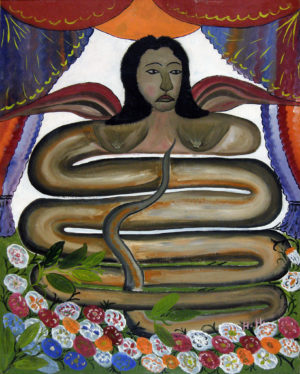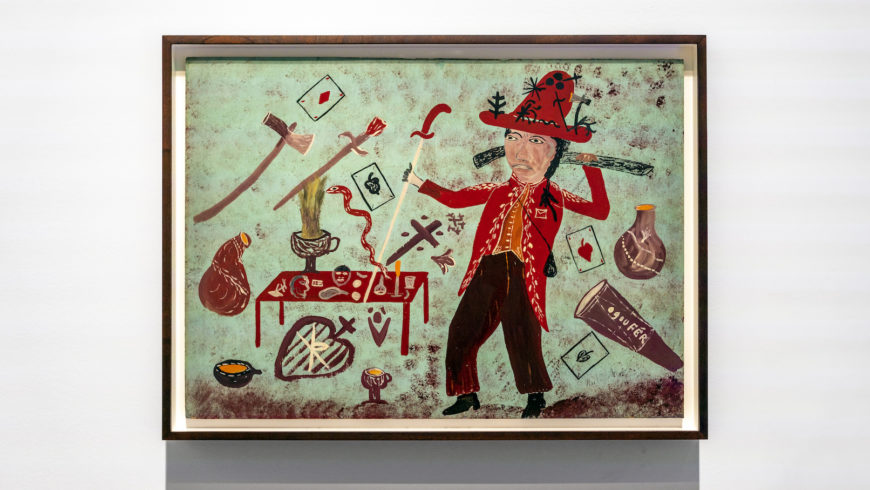
Hector Hyppolite, Ogou Feray also known as Ogoun Ferraille, c. 1945, oil paint on Masonite (The Museum of Everything, London; photo: Steven Zucker, CC BY-NC-SA 2.0)
Who is this man with a sword and a machete in his hands surrounded by symbols and objects that seem to float around him, including a table with a flaming chalice. He wears boots, a military-style coat above an orange vest, and tall red hat adorned with black symbols. His face is rather inscrutable, with an unfocused gaze and a slightly scowling mouth. He is Ogou Fer, also known as Ogou Feray, an important loa of the Haitian Vodou pantheon. The artist, Hector Hyppolite, created many paintings like this one that are tied to Vodou, for the burgeoning Haitian art market of the 1940s.
Vodou as subject and inspiration
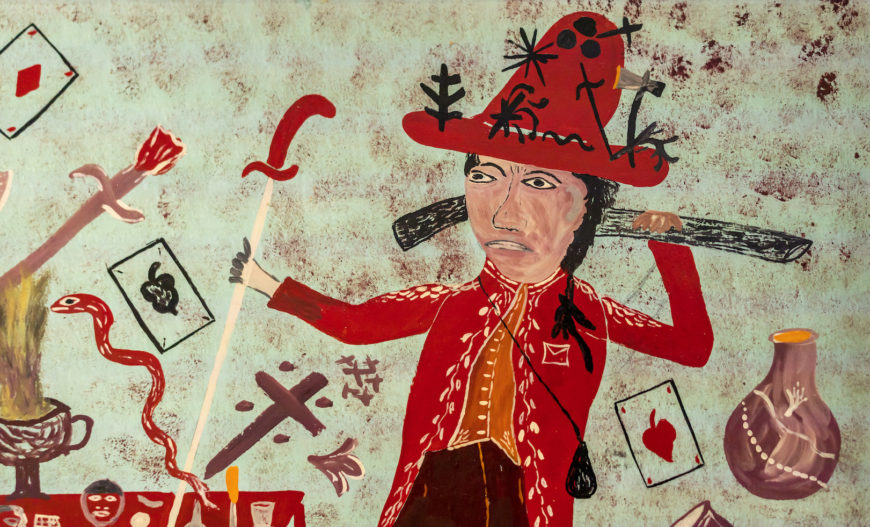
Hector Hyppolite, Ogou Feray also known as Ogoun Ferraille (detail), c. 1945, oil paint on Masonite (The Museum of Everything, London; photo: Steven Zucker, CC BY-NC-SA 2.0)
Vodou remains a popular religion in Haiti. Its origins are diverse, and it developed initially among the enslaved population during the Spanish and French colonial periods. Like other Afro-Caribbean religions (such as santería in Cuba), Vodou is characterized by syncretism (an amalgamation of different religions). Vodou’s rich visual and ritual culture builds on Fon, Yoruba, Kongo, Mbundu, and Mondongue religious beliefs from West and Central Africa and on Spanish and French Catholicism. People from Africa, or of African descent who were forced into the practice of Catholicism in the Caribbean made associations between Christian holy figures and the deities and narratives of their own religions. This was a way to continue practicing their original beliefs in secret while maintaining strong links to their African culture under the severe restrictions caused by slavery and colonial society. With time, this practice resulted in Haitian Vodou as a unique religious system.
Vodou acquired national significance during and after the Haitian Revolution, in part because it was credited with sparking the enslaved population’s involvement in the uprising. In the following centuries, Vodou was both esteemed and vilified. For example, in the 19th century, the autocratic president Faustin Soulouque publicly associated himself with the practice of the religion and sought its official acceptance. Then in the early 20th century anti-superstition campaigns were led by the government and the Church to eradicate its practice. All the while, Vodou continued as an important religious and cultural practice among the general Haitian population. Finally in 1946, it was properly legalized and became a popular subject of artistic production.
The artist, Hector Hyppolite, was a third generation houngan (Voudou priest) and was intimately familiar with the religion’s practice and imagery. He was a self-taught artist who specialized in decorative and religious art for use in oum’phors (Voudou temples). He became well-known in Haiti and internationally during the second half of the 1940s. Due to his relationship with the Centre d’Art in the Haitian capital of Port-au-Prince, he also produced works based on Vodou imagery for a market that attracted buyers and collectors from Europe and North America. It is likely that Ogou Feray also known as Ogoun Ferraille, was made for this audience, and the French Surrealist André Breton, bought this work from Hyppolite on his visit to Haiti in late 1945 and early 1946.
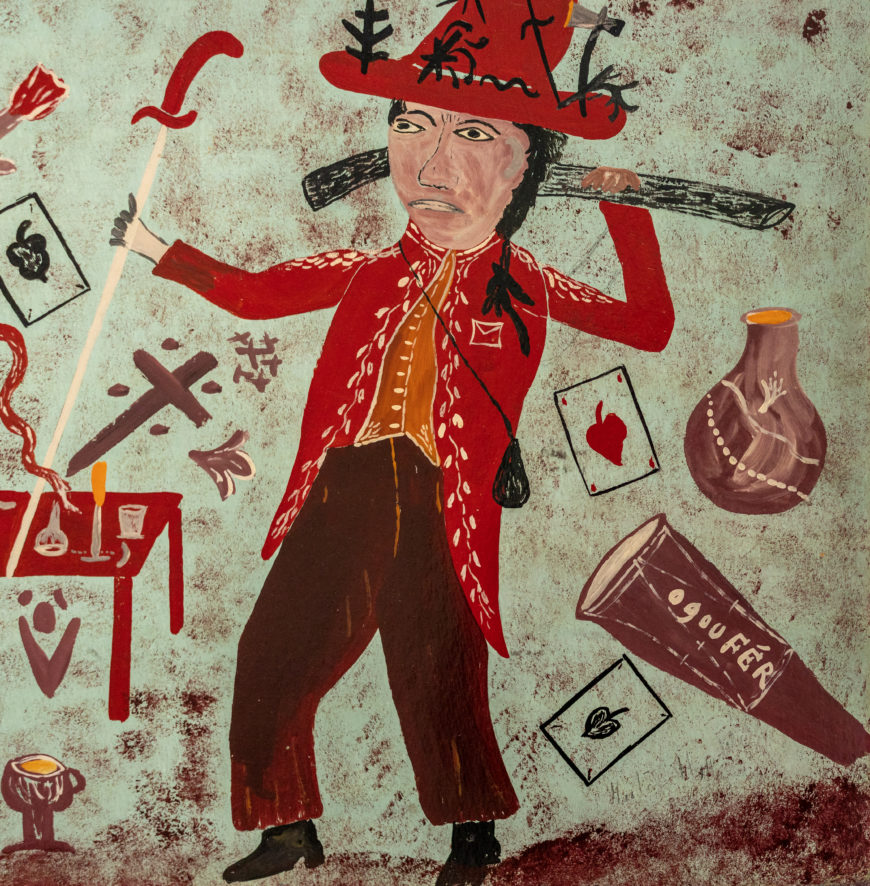
Hector Hyppolite, Ogou Feray also known as Ogoun Ferraille (detail), c. 1945, oil paint on Masonite (The Museum of Everything, London; photo: Steven Zucker, CC BY-NC-SA 2.0)
The painting
Besides the weapons he carries, Ogou Feray is easily identifiable by the drum that carries his name on the right portion of the composition and because he wears red, his color. Hyppolite took considerable liberty in the representation of loas (spirits or deities) but there are elements of the composition that point to this figure’s status and identity. [1] As a loa, he is linked with warfare, reason, and wisdom. [2] Military imagery and fire often accompany his representation and here we see swords, axes, and a burning lamp. Traditionally conceived as the loa who works with iron, Ogou Feray is also associated with blacksmiths.
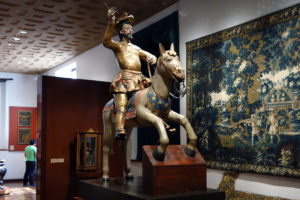
Santiago on Horseback, 16th century, polychromed and gilded wood, Mexico (Museo Franz Mayer, Mexico City, Mexico)
The prevalence of weapons, and military associations may be what led to Ogou Feray being linked with Saint James the Greater; a syncretic association related to the representation of James as the Moor-slayer (Santiago Matamoros). In this representation the saint is often shown in armor, riding a horse, and raising a sword to slay his foe. St. James the Great is the patron of Spain and his cult was popular in the Spanish Americas since the beginning of colonization. Armed angels and defensive saints were common throughout the Spanish Americas, with images of the Archangel Michael and St. James the Great popular as defenders of Christianity and Christians themselves. This was also the case in what would later become the nation of Haiti and may point to the early appearance of the syncretized Ogou Feray in the region.
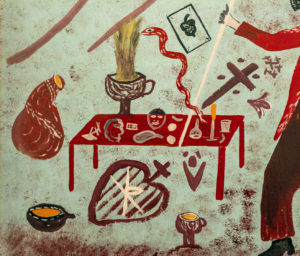
Hector Hyppolite, Ogou Feray also known as Ogoun Ferraille (detail), c. 1945, oil paint on Masonite (The Museum of Everything, London; photo: Steven Zucker, CC BY-NC-SA 2.0)
Many objects surround Ogou Feray in this painting (filled cups and vases, crosses, playing cards, and more). These objects and those on the table may allude to the type of offerings left at his altar. Offerings are often presented by the believer when wanting to ask a favor, when fulfilling a promise, or simply to please the loa. The snake that seems to float over the table may reference Danbhalah Wédo, a high-ranking deity in the Vodou pantheon. Danbhalah Wédo is a serpent-god, often represented as a great snake or as a figure with a head and upper chest of the human and the body of a snake.
The style of the work is representative of what became known as Haitian primitivism. Primitivism as an artistic trend developed in Europe in the latter half of the 19th century that rejected traditional aesthetic and formal conventions often associated with art academies and fascinated many in the European vanguard. The term was often used to describe non-Western art that was seen as authentic and uncorrupted while also naïve. It also was often used to refer to the style of self-taught and folk artists and to the work produced in non-industrial societies. We can see some of this in Ogou Feray, in the lack of depth in what seems to be an interior space and the flatness in the representation of Ogou Feray’s figure.
The making of Haitian primitivism
In 1944, the American artist and teacher DeWitt Peters opened the Centre d’Art in Port-au-Prince with the support of the writer Philippe Thoby-Marcelin and other local intellectuals and artists. Its goal was to offer art education and create a space for exhibitions and the sale of Haitian art to a local and international audience. It was there that Breton bought this painting. In its early years it sought primarily to showcase popular Haitian art, with work by artists such as Hyppolite, Philomé Obin, Rigaud Benoit, and Castera Bazile. Popular subjects included historic scenes and figures linked to the Revolution. Vodou was another prominent subject and source of inspiration—even among artists who were not practitioners of the religion.
The institution’s directors sought to attract international artists and create links with other Caribbean nations. People like the Martinican writer Aimé Césaire and Cuban painters Wifredo Lam and René Portocarrero visited the Centre in its first few years. The works showcased at the Centre, with their cultural and political subject matter and naïve style, became associated with notions of an authentic Haitian art. This is something that put the Centre at odds with mainstream and modernist Haitian artists, many of whom were formally trained and whose work was stylistically in dialogue with the international avant-garde movements. [3]
The concept of Haitian primitivism can be understood as a foreign interpretation of popular Haitian art. In its early period, the Centre created a narrative partly fed by foreign misconceptions of Haiti and the modernist fascination with Primitivism. Commercially this worked well for many of the artists connected with the Centre. Nevertheless, the production of popular artists who had been painting for decades before the Centre was founded, points to the long-established artistic tradition in the country.
Ogou Feray also known as Ogoun Ferraille encapsulates much of what made Hyppolite’s work so popular. A busy and bright composition that pulled from his vast catalog of Vodou imagery, which played a great role in attracting the attention of collectors and the international avant-garde. During his short but intense career, he became one of the most internationally famous artists from Haiti and saw his work purchased by European and North American artists and collectors, including MoMA’s Director René d’Harnoncourt. This all happened in the span of some three years, from 1945 to his sudden death from a heart attack in 1948.
Notes:
[1] Veerle Poupeye, Caribbean art (London: Thames and Hudson, 2022), p. 103.
[2] Milo Rigaud, Secrets of Voodoo (San Francisco, City Lights Books, 1985), p. 70.
[3] Veerle Poupeye, Caribbean art (London: Thames and Hudson, 2022), p. 88.
Additional resources
Gérald Alexis, “The Caribbean at the Hour of Haiti,” in Caribbean: Art at the Crossroads of the World (New York: El Museo del Barrio, 2012), pp. 107–23.
Veerle Poupeye, Caribbean art (London: Thames and Hudson, 2022), pp. 84–90, 103–39.
Terry Rey, “Toward an ethnohistory of Haitian pilgrimage,” Journal de la Société des américanistes 91, no 1 (Nanterre: Société des américanistes, January 2005): pp.161–83.
Milo Rigaud, Secrets of Voodoo (San Francisco, City Lights Books, 1985).

